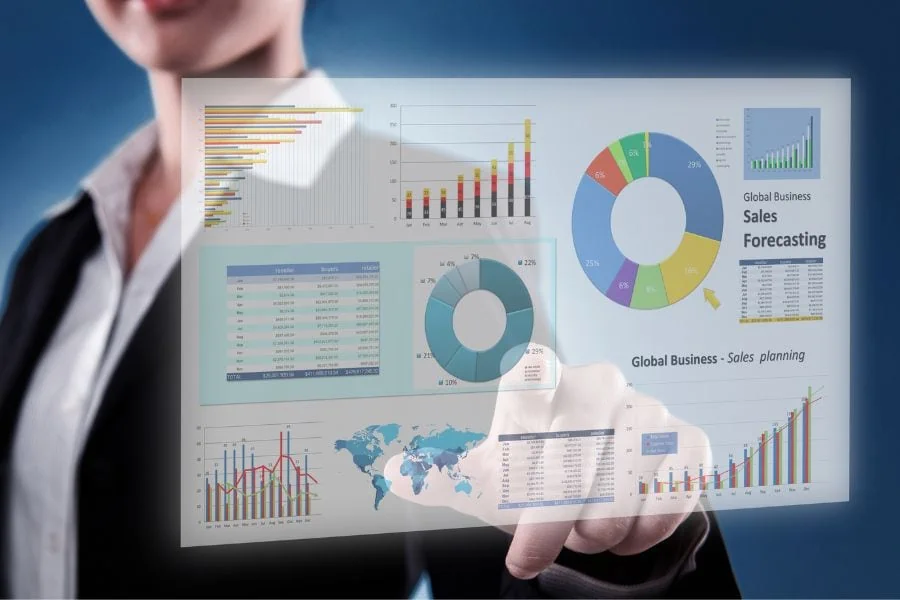2024’s 11 Biggest Trends In FP&A and Corporate Finance
Hello, fellow finance enthusiasts! There’s a certain thrill in sharing my journey with you today. As a kid, I was always intrigued by the world of numbers. The way they danced around, forming patterns, and in some strange way, telling stories. Well, it was only a matter of time before I fell head over heels for the world of finance.
My journey began with an entry-level job in a small firm where I juggled numbers for Financial Planning & Analysis (FP&A). Over time, I ventured into the broader spectrum of corporate finance, dealing with everything from investment decisions to capital structure. Now, let me tell you, it’s been quite a ride!
But why am I telling you all this? It’s simple. I want you to grasp the fact that the realm of FP&A and corporate finance isn’t just about dry numbers and complex jargon. It’s about understanding the pulse of a business, making sense of trends, and steering the financial wheel in the right direction.
And speaking of trends, we’re currently witnessing some game-changing ones. They’re transforming the way we plan, analyze, and manage finances. Understanding these trends is no longer a ‘nice-to-have’ but a ‘must-have.’ Why? Because they give us insights into the future, help us make smart decisions, and ultimately, keep our businesses thriving in an ever-evolving financial landscape.
So grab your favorite beverage, sit back, and let’s dive into these fascinating trends together. Buckle up, because it’s going to be an enlightening ride!
The 11 Biggest Finance Trends Of 2024
Trend #1: Increased Use of AI and Machine Learning

Think of AI and Machine Learning like your personal financial assistant. They can sift through mountains of data, spot patterns, make predictions, and offer insights that would take us mere mortals countless hours to crunch. And the best part? They’re getting smarter every day!
In fact, according to a recent survey by Gartner, 39% of Finance organizations are already using this technology.
Let me share a real-life example that will make this trend hit home. Picture a large corporation—let’s call it ‘Company X.’ Company X used to spend weeks every quarter painstakingly preparing financial forecasts. Then they decided to leverage AI. The result? Their forecasting process was not only faster but also more accurate. The AI system could analyze past trends, consider market fluctuations, and deliver spot-on forecasts. Talk about a game-changer!
So how can you start integrating AI into your financial processes? Start small. You don’t have to go all-in on the first go. Consider adopting AI-powered tools for tasks like data analysis or financial forecasting. Remember, it’s not about replacing humans; it’s about enhancing our capabilities.
Trend #2: The Rise of Real-Time Reporting

Now, let’s turn our attention to the next big wave in finance: real-time reporting. Imagine you’re watching a live sports match. You see every pass, every goal, every foul as it happens. Now, what if I told you that you could have the same ‘live’ experience with your finances? Well, that’s exactly what real-time reporting offers!
Real-time reporting is like having a 24/7 financial news channel dedicated solely to your business. It provides you with up-to-the-minute financial data, which means you can make decisions based on what’s happening right now, not what happened last month or last quarter.
Let me share a story about ‘Bakery B’, a small local bakery. They used to struggle with managing their finances due to delayed reports. Then they adopted a real-time reporting system. Suddenly, they could see exactly how much they were spending on ingredients, track sales as they happened, and even spot trends, like their red velvet cupcakes flying off the shelves every Friday afternoon! This insight helped them manage their inventory better, leading to reduced waste and increased profits. In short, real-time reporting was the secret ingredient in their recipe for financial success!
Trend #3: The Rise Of The T-Shaped Professional
So, what exactly is a T-shaped professional? Picture the letter ‘T’. The vertical line represents depth of expertise in a single field, in our case, finance. The horizontal line, however, represents the ability to collaborate across disciplines with experts in other areas and to apply knowledge in areas of expertise other than one’s own. So, a T-shaped professional is someone who has deep knowledge in finance but also has the ability to understand and connect with other areas of the business.
Think of a T-shaped professional as your friendly neighborhood finance whiz who not only knows his balance sheets and cash flow statements but can also hold a conversation with the marketing team about their latest campaign or discuss product development with the tech team. This broader perspective allows them to see the bigger picture and make better financial decisions that align with the overall business strategy.
Let’s illustrate this with a real-life example. Meet ‘Finance Fred’, a CFO at a mid-sized company. Fred is a finance guru, no doubt. But what sets Fred apart is his curiosity and willingness to step out of his finance bubble. He spends time understanding the ins and outs of different departments. He knows how the sales team operates, what the marketing team is planning, and even what challenges the IT team is facing. This wide-ranging knowledge helps Fred make more informed and holistic financial decisions for the company. In essence, Fred is a shining example of a T-shaped professional!
Trend #4: Self-Serve Reporting

Self-serve reporting is all about empowering you to access, analyze, and understand your financial data without having to rely on a finance whiz or IT guru. It’s like being handed the keys to your very own financial kingdom!
Imagine this: you’re in a meeting and someone asks a question about last quarter’s sales. Instead of saying, “I’ll have to check with the finance team”, you simply pull up the data on your device, right there and then. Now, that’s what I call empowerment!
Let’s talk about our friend ‘Cafe Carlos’, who runs a bustling coffee shop. Carlos used to depend heavily on his accountant for all financial reports. Then, he adopted a self-serve reporting tool. Now, Carlos can easily generate reports, track sales, and monitor expenses whenever he needs. He even noticed a pattern of increased sales on rainy days, leading him to stock more of his famous hot chocolate when the forecast calls for showers. With self-serve reporting, Carlos brewed up a storm of success in his business!
Trend #5: Robotic Process Automation

Think of robotic process automation as your friendly financial assistant who never sleeps. It’s like having a diligent worker bee that keeps your financial garden blooming while you’re busy tending to other parts of your business ecosystem.
Imagine you’re throwing a party (the business kind, not the disco-ball kind). You could spend hours in the kitchen cooking up a storm, or you could use a slow cooker, set it and forget it, and have more time to mingle with your guests. That’s what automation does for your finances. It takes care of routine tasks like data entry, invoicing, and reconciliation, freeing you up to focus on strategic decisions.
Take ‘Salon Sarah’, who owns a trendy hair salon. Initially, Sarah was swamped with paperwork – tracking appointments, managing invoices, and keeping up with expenses. Then she discovered the magic of automation. She switched to an automated booking system, implemented automated invoicing, and even got an app to track her expenses. Suddenly, she had more time to focus on her clients, create new hairstyles, and grow her business. Automation didn’t just give Sarah a financial makeover; it transformed her entire business!
Trend #6: Scenario Planning In A Disrupted Environment
Imagine you’re on a road trip. You’ve got your snacks, your favorite tunes, and you’re ready to hit the open road. But what if there’s a detour ahead or, heavens forbid, your car breaks down? Do you have a Plan B (or C or D)? That’s where scenario planning comes in. It’s all about preparing for different possible futures so that you’re not caught off guard when the unexpected happens.
In the business world, disruption is as certain as a pothole in a city street. Whether it’s a global pandemic, a sudden market crash, or a new competitor moving in next door, disruptions can throw your financial plans out of whack faster than you can say ‘balance sheet’!
But don’t panic! With scenario planning, you can navigate these disruptions like a seasoned sailor in stormy seas. It involves creating different financial models based on various potential scenarios. So, whether sales skyrocket, dip, or stay steady, you’ll have a plan to keep your business ship sailing smoothly.
Let’s revisit our friend ‘Cafe Carlos’. When the pandemic hit and his cafe had to close doors, Carlos was prepared. Thanks to his scenario planning, he had already modeled a ‘lockdown scenario’. He quickly pivoted to takeaway and delivery services, keeping his business brewing even in tough times. Carlos didn’t just survive the disruption; he thrived, all thanks to scenario planning!
Trend #7: Driver-Based Performance Management

Picture this: You’re in a car (let’s make it a shiny red sports car, just for fun). To reach your destination, you need to control various ‘drivers’, right? The steering wheel, the accelerator, the brakes…each one impacts your journey. Similarly, in your business, there are key ‘drivers’ that impact your financial performance – sales volume, operational efficiency, customer retention, and so on.
Driver Based Performance Management is all about identifying these key drivers, understanding how they influence your financial outcomes, and then managing them effectively. It’s like having a GPS for your business that shows you not just where you’re going, but how each turn (or decision) affects your route.
Consider our friend ‘Salon Sarah’. She identified her main drivers as the number of appointments, the average spend per client, and the cost of supplies. By focusing on these, she was able to increase her bookings, upsell additional services, and negotiate better deals with her suppliers. In other words, she didn’t just drive her business forward; she turbocharged it!
Trend #8: Sustainable Finance and ESG

Sustainable Finance isn’t just about saving polar bears or planting trees (although those are great things to do!). It’s about integrating environmental, social, and governance factors into your financial decision-making process. It’s like choosing to cycle to work instead of driving – you’re not just getting a good workout, but you’re also reducing your carbon footprint and improving air quality. Win-win, right?
Now, you might be wondering, “What does this have to do with my business finances?” Well, a lot! Just as consumers are becoming more conscious about where they spend their money (Hello, organic kale chips!), investors are also paying more attention to companies that prioritize ESG factors. They’re looking for businesses that not only generate profits but also create positive impact.
Let’s take our friend ‘Cafe Carlos’. He switched to using locally sourced organic coffee beans, implemented a recycling program in his cafe, and started providing fair wages and benefits to his employees. Not only did this enhance his reputation among customers, but it also attracted an investor who was keen on supporting sustainable businesses. Carlos didn’t just brew up a storm with his amazing coffee; he brewed a revolution in sustainable finance!
Trend #9: Integrated Business Planning
Integrated Business Planning (IBP) is like the conductor of the business orchestra. It ensures that every section – sales, finance, operations, and so on – is not just playing their own tune, but harmonizing together to create a beautiful symphony. It’s about aligning your business goals, strategies, and plans across all departments and levels. It’s like rowing a boat; if everyone rows in the same direction, you’re going to reach your destination a lot faster and more efficiently.
Let’s visit our friend ‘Bakery Betty’. She used to plan her finances, production, and marketing separately. But then, she discovered the magic of IBP. She brought her team together for a planning ‘potluck’. The result? They identified overlaps, gaps, and opportunities that they’d missed before. They streamlined processes, improved communication, and boosted profitability. Betty didn’t just bake delicious cakes; she baked up a powerful recipe for business success!
Trend #10: Shift Towards Strategic Advisory
Friends, we’ve arrived at the final destination of our financial trend journey – the Shift Towards Strategic Advisory. Imagine being a captain of a ship, with a trusty advisor by your side, helping you navigate through stormy seas and calm waters alike. That’s exactly what this trend is all about!
In the world of finance, we’re seeing a major shift from traditional number-crunching roles to more strategic advisory positions. It’s like swapping your calculator for a compass. Instead of just tallying up figures, finance professionals are now expected to provide strategic advice, make forecasts, and help shape business decisions. They’re not just bean counters; they’re becoming the co-pilots of the business ship!
Let’s take a look at ‘Techy Tom’. He runs a successful tech startup, but finance isn’t his strong suit. So, he brought in a strategic advisor who didn’t just manage his books but also provided valuable insights into his business performance, helped set financial targets, and guided him on investment decisions. With his advisor’s help, Tom didn’t just build a great product; he built a financially solid business!
Trend 11: Data-Driven Decision Making
Data-Driven Decision Making is like having a magic crystal ball that can predict the future. Well, not exactly, but it’s pretty close! It involves collecting and analyzing data from various sources to make informed business decisions. It’s like going on a treasure hunt, where the treasure is valuable insights that can help your business grow.
Let’s visit ‘Pizzeria Pete’. He used to make decisions based on gut feelings and assumptions. Then, he discovered the power of data. He started tracking his sales, customer behaviors, and market trends. The result? He found patterns and insights that helped him optimize his menu, improve his marketing, and increase his profits. Pete didn’t just make delicious pizzas; he cooked up a storm with his data-driven decisions!
Why Are FP&A And Corporate Finance Changing?
Financial Planning & Analysis (FP&A) and corporate finance are evolving rapidly due to several factors:
- Technological Advancements: The increasing use of advanced technologies like Artificial Intelligence (AI), Machine Learning (ML), and predictive analytics is transforming FP&A and corporate finance. These technologies are automating routine tasks, improve accuracy in financial forecasting, and providing deeper insights into financial data.
- Inflation And Tight Labor Market: It is a hard time for a company to hire, and when they do hire, it is costly. Companies are turning to automation and technology to reduce labor costs while increasing their efficiency and accuracy of critical financial tasks.
- Increasing Complexity of Financial Regulations: The financial regulatory environment is becoming more complex, with new rules and standards regularly introduced. This challenge drives changes in corporate finance practices, as companies must adapt their financial compliance processes to meet these new requirements.
- Globalization: Businesses increasingly operate across borders, introducing additional complexity into finance. FP&A professionals must consider factors like exchange rates, international tax laws, and geopolitical risks in their financial forecasts.
- Changing Business Models: As businesses adapt to changing market conditions and customer preferences, their business models evolve. This challenge requires new approaches to finance support these new business models.
- Increased Focus on Risk Management: In today’s uncertain business environment, there’s a greater focus on risk management in corporate finance. Companies are investing more in identifying, assessing, and managing financial risks to ensure their financial stability.
Quick Recap
Financial planning and analysis (FP&A) is becoming increasingly important to businesses as they strive to make informed decisions. Companies leverage cloud-based solutions, data visualization tools, strategic advisory services, sustainability metrics, blockchain technology, and traceability systems to understand their financial performance better. These tools can help organizations gain valuable insights into their financials and make better decisions in order to remain competitive.
FP&A teams are also becoming more involved in strategic decision-making, providing valuable input to the business on major decisions. With all of these advancements, it’s clear that the role of corporate finance is growing in importance for any organization looking to succeed in today’s economy.
Frequently Asked Questions
How Can I Stay On Top Of FP&A Trends?
Keeping up-to-date on FP&A trends is essential for staying ahead of the competition. Make sure to stay abreast of new technologies and business strategies, attend industry conferences to network with other professionals, and join relevant online forums and discussion groups. Additionally, subscribing to newsletters related to FP&A can help you keep track of the latest trends in the field.
What Are Some Common Challenges Faced By FP&A Professionals?
Some of the most common challenges faced by FP&A professionals include data accuracy and reliability, lack of access to real-time data, managing a budgeting process that involves multiple stakeholders with competing agendas, dealing with conflicting interests between different departments, and ensuring compliance with regulatory requirements. Additionally, FP&A teams must be able to quickly identify and respond to market or internal operations changes that could impact their financial performance.
What Are The Benefits Of Automation For FP&A?
Automating the FP&A process can help streamline workflows, improve accuracy and reliability of financial models, reduce manual labor, and enable faster decision-making. Additionally, automation can provide improved transparency into data sources and better insights into trends that could impact performance. These benefits are critical for ensuring success in FP&A’s fast-paced and ever-evolving world of FP&A.
What Are The Benefits Of Utilizing Software Solutions For FP&A?
Using software solutions for FP&A can help streamline processes, increase accuracy, save time, reduce manual labor, and provide access to real-time data. Additionally, these solutions can enable faster decision-making by providing better insights into trends, and improved transparency into data sources. Finally, software solutions can help FP&A teams easily manage complex budgets with multiple stakeholders with competing agendas.
Have any questions? Are there other topics you would like us to cover? Leave a comment below and let us know! Remember to subscribe to our Newsletter to receive exclusive financial news in your inbox.

